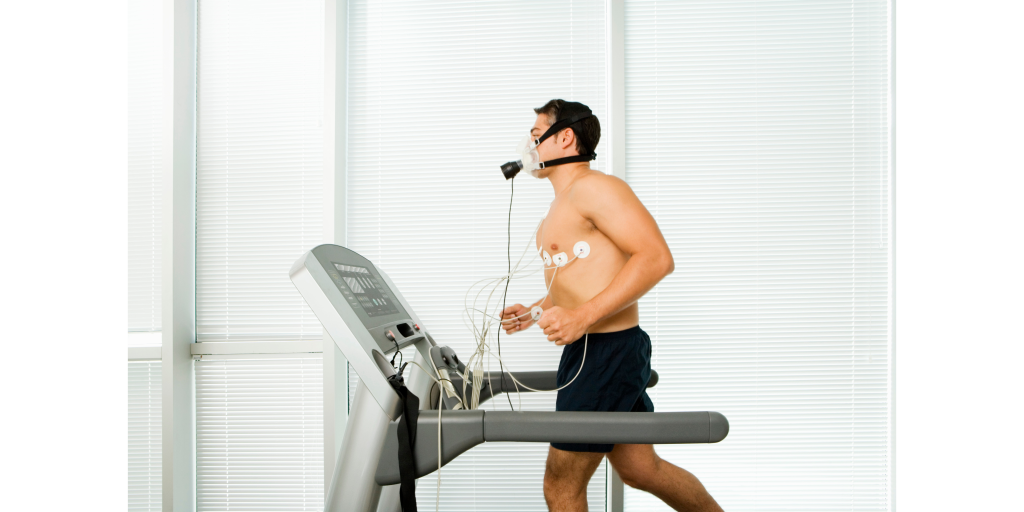Oleh: Thalia Kaylyn Averil
Cardiopulmonary Exercise Testing (CPET) atau uji latihan kardiopulmonal adalah teknik diagnostik yang digunakan untuk menilai kemampuan fungsional dari pasien. CPET mengukur kapasitas seseorang untuk berolahraga dan memberikan informasi mengenai reaksi jantung dan paru-paru terhadap hal tersebut. Tes ini dapat membantu dalam pembuatan rencana terapi dan rehabilitasi yang sesuai dengan pasien. Selain itu, CPET juga dapat memberikan berbagai informasi tentang proses yang mendasari penyakit di jantung dan paru-paru, jantung dan paru-paru adalah organ tubuh yang berkaitan karena keduanya saling memengaruhi satu sama lain.

Gambar 1. Cardiopulmonary Exercise Testing (CPET).
Data-data yang dikumpulkan selama CPET meliputi hasil elektrokardiogram (EKG), denyut jantung, jumlah oksigen (O2) yang diserap, dan jumlah karbon dioksida (CO2) yang diproduksi. Ventilasi per menit dan konsumsi oksigen maksimal (VO2 maks) dapat dihitung dari data-data yang terkumpul sehingga tenaga kesehatan dapat mengevaluasi fungsi kardiopulmonal keseluruhan pasien. CPET berpotensi untuk digunakan dalam evaluasi pemulihan pasca operasi, diagnosis berbagai penyakit kardiopulmonal, penilaian risiko sebelum operasi, dan penilaian umum kapasitas latihan pasien.
CPET ini berguna sebagai alat diagnostik untuk berbagai macam penyakit terkait kardiopulmonal karena dapat memberikan banyak informasi tentang sistem fisiologis tubuh. Indikasi penggunaan CPET adalah sebagai berikut:
- Menentukan penyebab latihan fisik yang terbatas
- Mengevaluasi status fungsional
- Menilai risiko untuk pembedahan
- Memprediksi hasil dari proses penyakit tertentu
- Membuat jadwal latihan yang spesifik untuk program rehabilitasi
Ada banyak aplikasi untuk pengujian latihan kardiopulmoner dalam klinis. Hal ini digunakan untuk mendeteksi dugaan penyakit jantung dan paru-paru serta tingkat keparahan penyakit, mengevaluasi kapasitas latihan, menilai risiko prosedur pembedahan yang direncanakan, dan mengidentifikasi penyebab sesak napas yang tidak dapat dijelaskan. Selain itu, CPET digunakan untuk memetakan perjalanan penyakit progresif atau menilai pengobatan, mendeteksi asma akibat olahraga, menilai kebugaran fisik, dan menilai status serta pengobatan penyakit jantung dan paru-paru. Hal ini juga dapat diterapkan untuk mengevaluasi kondisi pembedahan atau efektivitas program rehabilitasi. CPET adalah alat diagnostik yang berguna untuk sejumlah gangguan kardiopulmoner, serta untuk menentukan kapasitas olahraga dan memantau respons jantung dan paru-paru terhadap olahraga.
CPET dapat memberikan banyak manfaat untuk atlet, terutama untuk evaluasi fungsi terintegrasi jantung, paru-paru, pembuluh darah, dan otot selama latihan. Manfaat lainnya termasuk:
- CPET membantu menyesuaikan program latihan yang optimal dengan memberikan informasi yang detail, seperti profil hemodinamik, pertukaran gas saat berolahraga, dan volume pengambilan oksigen yang dicapai pada ambang batas anaerobik.
- CPET membantu membedakan antara adaptasi yang normal dan potensi terjadinya penyakit pada atlet, seperti kardiomiopati dini. Dengan menilai fisiologi latihan, keterbatasan atau kelainan yang mempengaruhi kinerja atlet dapat diidentifikasi.
Langkah pertama dalam CPET adalah tes fungsi paru, seperti spirometri. Selama prosedur, jantung dan paru-paru selama latihan akan terus dipantau sehingga memberikan data yang dibutuhkan untuk pengambilan keputusan klinis. Data yang menggambarkan bagaimana jantung dan paru-paru bereaksi terhadap olahraga dikumpulkan secara terus-menerus dan dirata-ratakan dalam interval 20 hingga 30 detik sehingga tenaga kesehatan mendapatkan informasi yang komprehensif. CPET memungkinkan analisis oksigen dan karbon dioksida yang dihirup dan dikeluarkan secara langsung, serta pengukuran gas yang dikeluarkan dengan setiap napas. Transduser aliran udara dapat digunakan untuk mengukur volume udara yang dihirup dan dikeluarkan. Latihan biasanya dilakukan pada treadmill atau sepeda stasioner. Resistensi yang lebih tinggi dapat diberikan oleh salah satu modalitas untuk menunjukkan kerja tubuh pasien dari waktu ke waktu. Konsumsi oksigen maksimal 5% hingga 20% lebih tinggi pada pasien yang menggunakan treadmill daripada pasien yang menggunakan ergometer sepeda karena treadmill melibatkan lebih banyak kelompok otot. Peralatan tambahan termasuk komputer, analisis gas, serta layar yang menampilkan analisis EKG 12-lead dan perubahan fisiologis yang disebabkan oleh latihan.
Berikut adalah hal-hal yang dapat dilakukan sebelum menjalani prosedur. Pedoman ini dapat sedikit berbeda di antara laboratorium, tetapi hal-hal berikut adalah pedoman standar:
- Gunakan pakaian yang longgar dan nyaman serta sepatu yang bisa digunakan untuk berlari, berjalan, atau mengayuh sepeda.
- Hindari berolahraga pada hari pemeriksaan.
- Pada hari pemeriksaan, makanlah sedikit dan sebaiknya tidak makan apapun selama tiga hingga empat jam sebelum tes.
- Usahakan untuk tidak mengonsumsi kafein pada hari pemeriksaan.
- Hindari merokok pada hari pemeriksaan.
- Jika Anda sedang mengonsumsi obat secara rutin, silakan untuk membawa daftar obat yang Anda konsumsi. Pada hari pemeriksaan, umumnya disarankan untuk mengonsumsi semua obat rutin Anda, tetapi terkadang inhaler harus berhenti digunakan.
CPET juga dapat menjadi alat skrining yang digunakan untuk mendeteksi atau menentukan tingkat keparahan penyakit jantung dan paru-paru yang dicurigai. CPET adalah alat diagnostik yang berguna untuk sejumlah gangguan kardiopulmonal, serta untuk menentukan kapasitas olahraga dan melihat respons jantung dan paru-paru terhadap olahraga. Jika Anda ingin melakukan skrining untuk jantung dan paru-paru Anda, Cardiopulmonary Exercise Testing (CPET) telah tersedia di Rumah Sakit Abdi Waluyo.

Gambar 2. Cardiopulmonary Exercise Testing (CPET) di Rumah Sakit Abdi Waluyo.
Referensi:
- Razvi Y, Ladie DE. Cardiopulmonary Exercise Testing. [Updated 2023 Apr 24]. In: StatPearls [Internet]. Treasure Island (FL): StatPearls Publishing; 2024 Jan-. Available from: https://www.ncbi.nlm.nih.gov/books/NBK557886/
- Albouaini K, Egred M, Alahmar A, Wright DJ. Cardiopulmonary exercise testing and its application. Postgrad Med J. 2007 Nov;83(985):675-82. doi: 10.1136/hrt.2007.121558. PMID: 17989266; PMCID: PMC2734442. Available from: https://ncbi.nlm.nih.gov/pmc/articles/PMC2734442/
- American Thoracic Society. Cardiopulmonary exercise test (CPET) [Internet]. New York: American Thoracic Society; 2020 [cited 2024 Feb 20]. Available from: https://www.thoracic.org/patients/patient-resources/resources/cpet.pdf
- Triantafyllidi H, Birmpa D, Benas D, Trivilou P, Fambri A, Iliodromitis EK. Cardiopulmonary exercise testing: the BAC for the clinical cardiologist. Karger [Internet]. 2021 Oct 14 [cited 2024 Feb 20];47(1):62–71. Available from: https://karger.com/crd/article/147/1/62/822323/Cardiopulmonary-Exercise-Testing-The-ABC-for-the
